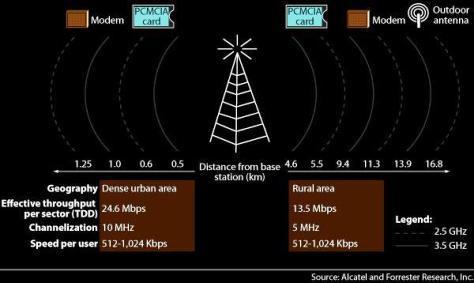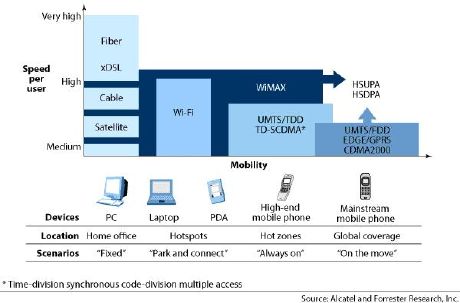Guest Post by Babar Bhatti
 Pakistan’s telecommunication industry – mobile communication in particular – has made impressive strides in the last few years after deregulation. However broadband growth in the country has been very disappointing – there are less than 100,000 broadband users in Pakistan. The open competition observed in mobile industry has not been replicated to broadband. Reasons include high prices, control of PTCL over bandwidth resources, policy issues, lack of infrastructure and legal disputes.
Pakistan’s telecommunication industry – mobile communication in particular – has made impressive strides in the last few years after deregulation. However broadband growth in the country has been very disappointing – there are less than 100,000 broadband users in Pakistan. The open competition observed in mobile industry has not been replicated to broadband. Reasons include high prices, control of PTCL over bandwidth resources, policy issues, lack of infrastructure and legal disputes.
Enter WiMAX. Simply stated, it’s a relatively new standards-based wireless technology which is intended for large coverage areas on the order of several kilometers (instead of a few hundred meters, as is the case with Wi-Fi).
With base stations transmitting signals and some equipment at customer location, it promises fast bandwidth for both fixed locations and mobile users. In this backdrop, Pakistan made headlines in 2006 when Wateen announced plans to work with Motorola to rollout Mobile WiMAX, the largest network of its kind in the world.
Is WiMAX (Worldwide Interoperability for Microwave Access) the right technology for developing countries? In other words, will this new technology deliver the promise of broadband at affordable prices?

WiMAX comes with many theoretical advantages but its potential is yet unproven. Without getting too technical, it is purpose-built for Internet (IP) communication and is based on standards (as opposed to other proprietary solutions) endorsed by a respected world standards body, the Institute of Electrical & Electronic Engineers (IEEE)*.
In 2002 WiMAX was identified by Intel as an alternative or complement to the wireless broadband. Eventually Motorola and Intel became its biggest champions. On the other side of the camp were GSM operators of the world who saw WiMAX as a competing technology. As with any new technology, a lot of lobbying was done to make it an industry wide accepted technology. According to BusinessWeek,
“(Intel) rounded up a remarkable coalition of chip, PC, consumer electronics, networking, and software companies in an effort to radically reshape the future of broadband with what’s now called WiMAX.”
In addition to broadband Internet access, applications that are supportable with WiMAX supports multiplayer interactive gaming, streaming media, VoIP, video and teleconferencing, and media content downloads.
Even today the industry is full of discussions and debates, comparing WiMAX with technologies such as 3G. About 65 countries are experimenting with WiMAX and the results will vary by country depending on the spectrum availability, existing infrastructure and market conditions.
Coming back to Pakistan, the major initiatives include:
(1) Wateen – which is using WiMAX solution from Motorola and its cable/fiber network to offer triple play of phone, TV and broadband. Trials have been extended for over a year. Most aggressive to market their bundled solutions, they have started advertising without providing pricing and availability information.
(2) Mobilink – has formed a new entity called Link Dot Net (LDN) to focus on broadband market. WiMAX infrastructure was piloted by Mobilink in 3 cities and a recently issued RFP has generated 7 proposals to cover 5 major metros, including in-building coverage for high value business areas. Malaysia’s Dancom, which conducted early trials of WiMAX in Karachi, was acquired by Mobilink’s LDN in 2007. Mobilink also bought DV Com and its licenses.
(3) Burraq Telecom – which was acquired by ACT consortium which includes Qatar Telecom and Clearwire Corporation, an American operator providing WiMAX services in 10 countries, also plans to offer WiMAX.
The pricing has not been announced by these companies yet. Business users in Pakistan desperately need reliable broadband and are the desired customers because of their high affordability levels. Consumer market is different as demand varies by demographics’ low price is the dominating success factor.

Currently the high prices of WiMAX ‘customer premises equipment’ (CPE) make it more expensive than fiber, cable or DSL. Wateen and others are counting on the trend of falling hardware prices for WiMAX. They would have to compete with the latest PTCL broadband campaign in which PTCL has dramatically reduced DSL prices at Rs 1200 per month for 256kbps speed with a 2GB limit. As a last mile solution, WiMAX may not compete on price at this time but if WiMAX is reliable, fast and operators provide better customer service then business users may pay some premium for it, say as a replacement for leased lines.
There are other potential benefits of WiMAX such as broadband access for rural areas or for areas that have no other reasonable broadband access. This is likely to be play an important role for developing countries. WiMAX can also reduce cost of transmission lines such as backhauls from cellular sites or cross-town links. To summarize, improved access and mobility are the major advantages promised by the WiMAX camp.
What about the existing telecom infrastructure in Pakistan? For one, the GSM infrastructure in Pakistan is mainly focused on voice. 3G licenses are expected to be awarded at the end of 2007, paving the way for HSDPA – the high speed standard for GSM – in Pakistan . The existing 2 or 2.5G mobile Internet is available in selected areas and the number of users for the mobile broadband services remains low. It is yet to be seen if WiMAX, with its higher speeds** and costs, will find a large number of users in this category in Pakistan.
Spectrum is another important factor – even a show-stopper – in many countries where spectrum availability can mean all the difference. For Pakistan, PTA, the communications regulatory body has allocated spectrum in 3.5 GHz range for WiMAX. The CDMA wireless phone operators such as PTCL (Vfone) and Worldcall, which offer limited mobility, also have licenses in the 3.5GHz range and they are also likely to offer WiMAX services after getting approvals from PTA.
Notes:
* Fixed and mobile WiMAX are the 2 major choices, the standards for fixed (IEEE 802.16d) were defined in 2004; the mobile standard (IEEE 802.16e) has been recently finalized. WiMAX 802.16d has limited radio features; enhanced and standardized interoperable radio performance comes with WiMAX 802.16e.
** The claimed speeds for WiMAX vary making it difficult for people to get an idea of the real-life performance they are expected to get.
References: Motorola: [1] and [2] Wateen: [3] and [4] Others: [5], [6], and [7]




















































WiMAX will also allow hard-to-reach communities get wireless/internet access. This gives them a leap forward without having to go through traditional land lines based communications first.
Babar
thanks for the informative piece. Being a complete Wimax illiterate, this was an eye opener..
To add my two cents on the topic,
good to know that wimax is on trial on pakistan. Engineers would get good experience which could lead to an improvement in the ecosystem for tech dvelopment in the region.
i work with a wireless supplier and currently the equipment we sell for mobile operators gives HSDPA downlink speeds of 3.6 Mbps. By end of the year, we are launching 14.4Mbps DL and 1.4Mbps UL for several customers around the globe.
So in principle, major vendors ericsson / nokia siemens / alcatel lucent are providing good download rates on commercial 3G networks and all major operators around the world are going down this path.
In addition, data cards are available that support these throughputs. I think a 3.6Megs card from Huewei / Novatel / Option is costing around 300$ or so. I also saw this Huewei USB port that you connect on your desktop to make it go mobile. Commercial handsets from Samsung u700?/ Nokia N95 etc are available now that are mobile phones but also do this HSDPA stuff. Pretty fance and good looking! N95 does cool GPS and also has a 5 megapixel camera etc.
So, in essense, in all western markets, 3G / HSDPA is commercially available and doing fine. It appears to do well in markets like South Africa / Indonesia where the fixed infrastructure is bad. In europeon markets, it seems to be doing well in countries where people are talkative / socially connected like Italy. (as opposed to germany!).
There is a bit of problem in India, Pakistan, China – the governments have not freed up the 2100MHz band which is required for the roll out of 3G services. Due to this, operators cannot rollout 3G services although there are good phones, cheap equipment available to rollout the fancy 3-14Mbps on the mobile networks. Another addon coming up on the mobile markets is the DVB-H or similar solutions – watch TV on your phone.
So, although Wimax is creeping in pakistan, and it is good to have, – but it is too expensive and probably would not be price competitive since the land line / cable infracture has improved in Pakistan- atleast in the cities.
Come 3G licenses, (give or take one year), and wimax will be out of fashion in pakistan.
There are no mobiles that support mobile phone + wimax at the same time – atleast from what I know.
jnz
Nice Article,
I have been following WIMAX as well in comparison with HSDPA. The only concern is the WiMaX being deployed by the big corporations who would exorbitantly charge for their products and services.
Also does anyone know what is their roadmap for deploying 802.16e ie the mobie wimax standard
Excellent Article on WiMAX. I have been following WiMAX fourms for two years now and the most exciting news i got was when Motorola announced the LARGEST network in Pakistan. Pakistan is in dire need of a cheap and more efficient way of connecting to the internet. I am so excited about WiMAX and glad that big corporation are endorsing such standards to promote new technology at a more affordable rate.
WiMAX would roll out slow since it is one of a kind project in Pakistan and their is of course some in-house politics which might further delay the deployment of WiMAX. Nonetheless, i am very excited and looking forward to see WiMAX in an area where wired Telecommunication structure is not as strong.